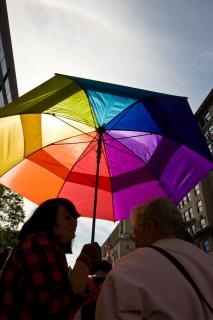Inclusive Language
“Examining and extending our language gives us a chance to broaden our definition of the word we.”
—Rev. Barbara Pescan
Being a welcoming and inclusive community means consciously working to find ways to name, honor, and value experiences and identities that are usually minimized or devalued. It means uncovering our unconscious assumptions about what’s “normal” and who is present in our community, and opening ourselves to the possibility of greater diversity. In order for us each to feel welcome and included in faith communities, we need to see ourselves reflected and present in some way.
Using inclusive language does not just mean using welcoming and affirming statements, although that is certainly a good first step. Increasing the inclusiveness of our language means striving to understand the ways that language often unconsciously makes assumptions about people and unintentionally reinforces dominant norms around gender, sexual orientation, race, class, ability/disability, age, and other identities and experiences. Here are a few things to be mindful around (in terms of checking the assumptions that language often carries):
- Recognize diverse family formation
For example, some families are headed by single parents, grandparents, foster parents, two moms, two dads, and more: consider “parent or caregiver” instead of “mom and dad,” get creative with Mother’s Day and Father’s Day, etc. - Use language that reflects what people call themselves
For example, taking the time to find out what labels or words a person or group uses for their identities and experiences rather than making assumptions, and always respecting the language a person uses to self-identify. - Use “person-centered” language as a general rule
For example, when talking about groups you aren’t a member of, not using an identity as a stand-in for a person or a group: “people with disabilities” instead of “the disabled”; “transgender people” instead of “transgenders” or “the transgendered”; etc., remembering that any aspect of a person is just that: an aspect of a person. - Understand and respect the difference between sexual orientation and gender identity
For example, not saying “LGBT” if you are only talking about sexual orientation; not using “straight” as the opposite of “LGBT” (transgender people can be any sexual orientation, including straight); etc. - Be intentional about representing diversity in stories and curricula
For example, representing a variety of family structures, races/ethnicities, gender identities and expressions, and sexual orientations in stories shared during services and in religious education for all ages. - Consider non-gendered words for the divine
- Use words that encompass all genders rather than only two
For example, “people of all genders” instead of “women and men”; “children” instead of “boys and girls”; “siblings” or “kindred” instead of “brothers and sisters.” - Use language that does not assume a certain level of education
For example, not assuming that all people have graduated from high school and/or gone to college (or will go to college after high school); being mindful of the reading level of language used in services; etc. - Use language that does not assume a certain level of financial means or certain sort of vocation
For example, not assuming that everyone present is employed, has a stable living situation, can afford to meet their basic needs, works a first shift job, etc. - Use language that does not assume all people are heterosexual
- Avoid negative or demeaning language for people with disabilities
For example, “people living with HIV/AIDS” rather than “AIDS victims”; “people who use wheelchairs” rather than “wheelchair-bound” or “someone confined to a wheelchair.” - Be thoughtful about the imagery you use
For example, words like “black,” “dark,” and “blind” are often used symbolically to express negative concepts. There are many alternatives and ways to diversify our use of certain symbolism.
“As our language becomes more and more inclusive, and as the language in this our era ‘redeems’ more and more words which were once eschewed by many of us (God, Spirit, even Church and Religion) may our primary discipline be to love and include, not ‘to convert’ and lay down rules. The remaking of our language is not necessarily painless, but if we begin with our humanity … we can also remember how to bring some healing to that pain.”
—Rev. Mark Belletini, ~1990
Do you have questions, comments, or more ideas for inclusive language to add to the guidance above? Contact lgbtq@uua.org!
If you like this page, you might also be interested in Multicultural Welcome: A Resource for Greeters and Coffee Hour Caution: Advice for Older Adults Greeting Young Adults. You can also find out more about nurturing inclusivity in our congregations.

